Preparation, Characterization and In Vitro Biological Activities of New Diphenylsulphone Derived Schiff Base Ligands and Their Co(II) Complexes
Abstract
1. Introduction
2. Experimental
2.1. Materials and Methods
2.2. Chemical Synthesis
2.2.1. Preparation of Schiff Base Ligands (L1–L5)
2,2′-(4,4′-Sulfonylbis(4,1-phenylene)bis(azan-1-yl-1-ylidene))bis(methan-1-yl-1-ylidene)-diphenol (L1)
1,1′-(4,4′-Sulfonylbis(4,1-phenylene)bis(azan-1-yl-1-ylidene))bis(methan-1-yl-1-ylidene)-dinapthalen-2-ol (L2)
2,2′-(4,4′-Sulfonylbis(4,1-phenylene)bis(azan-1-yl-1-ylidene))bis(methan-1-yl-1-ylidene)bis-(4-bromophenol) (L3)
6,6′-(4,4′-Sulfonylbis(4,1-phenylene)bis(azan-1-yl-1-ylidene))bis(methan-1-yl-1-ylidene)bis-(2-methoxyphenol) (L4)
2,2′-(4,4′-Sulfonylbis(4,1-phenylene)bis(azan-1-yl-1-ylidene))bis(methan-1-yl-1-ylidene)bis-(4-chlorophenol) (L5)
2.2.2. Synthesis of Co(II) Complexes (C1–C5)
2.3. Biological Assay
2.3.1. Antimicrobial Studies
2.3.2. Molecular Docking Studies
2.3.3. Anticancer Activities by SRB Assay
3. Results and Discussion
3.1. Electronic Spectral Studies amd Magnetic Moment Studies
3.2. FT- IR Spectral Studies
3.3. 1H-NMR Spectral Studies
3.4. Thermogravimetric Analysis
3.5. Mass Spectral Studies
3.6. Antibacterial and Antifungal Activities
3.7. Molecular Docking Studies
3.8. Effect of Ligands (L1–L5) and Their Complexes (C1–C5) on Antiproliferative Activity
4. Conclusions
Supplementary Materials
Author Contributions
Funding
Institutional Review Board Statement
Informed Consent Statement
Data Availability Statement
Acknowledgments
Conflicts of Interest
References
- Khandar, A.A.; Nejati, K.; Rezvani, Z. Syntheses, Characterization and Study of the Use of Cobalt (II) Schiff–Base Complexes as Catalysts for the Oxidation of Styrene by Molecular Oxygen. Molecules 2005, 10, 302–311. [Google Scholar] [CrossRef] [PubMed]
- Martell, A.E.; Sawyer, D.T. Oxygen-Co Complexes and Oxygen Activation by Transition Metals; Plenum Press: New York, NY, USA, 1998. [Google Scholar]
- Nagata, T.; Yorozu, K.; Yamada, T.; Mukaiyama, T. Enantioselective Reduction of Ketones with Sodium Borohydride, Catalyzed by Optically Active (β-Oxoaldiminato)cobalt(II) Complexes. Angew. Chem. Int. Ed. 1995, 34, 2145. [Google Scholar] [CrossRef]
- Estiú, G.L.; Jubert, A.H.; Costamagna, J.; Vargas, J. Quantum Chemical Calculations of the Structures and Electronic Properties of N,N‘- Bis(3,5-dibromosalicylidene)-1,2-diaminobenzene and Its Cobalt(II) Complex. Origin of the Redox Activity of the Cobalt Complex. Inorg. Chem. 1996, 35, 263–266. [Google Scholar] [CrossRef] [PubMed]
- Zhang, Y.-L.; Ruan, W.-J.; Zhao, X.-J.; Wang, H.-G.; Zhu, Z.-A. Synthesis and characterization of axial coordination cobalt(III) complexes containing chiral Salen ligands. Polyhedron 2003, 22, 1535–1545. [Google Scholar] [CrossRef]
- Cini, R.; Moore, S.J.; Marzilli, L.G. Strong Trans Influence Methoxymethyl Ligand in B12 Cobaloxime and Imine/Oxime Model Complexes: Structural, Spectroscopic, and Molecular Mechanics Investigations. Inorg. Chem. 1998, 37, 6890. [Google Scholar] [CrossRef]
- Sethi, R.; Ahuja, M. Synthesis, Characterization and Antibacterial Activity of Cobalt Complex of 2-Pyrazoline with Pyridinyl MoietyInt. J. Pharm. Technol. Res. 2016, 9, 35. [Google Scholar]
- Ghosh, P.; Chowdhury, A.R.; Saha, S.K.; Ghosh, M.; Pal, M.; Murmu, N.C.; Banerjee, P. Synthesis and characterization of redox non-innocent cobalt(III) complexes of a O,N,O donor ligand: Radical generation, semi-conductivity, antibacterial and anticancer activities. Inorganica Chim. Acta 2015, 429, 99–108. [Google Scholar] [CrossRef]
- Ghosh, M.; Layek, M.; Fleck, M.; Saha, R.; Bandyopadhyay, D. Synthesis, crystal structure and antibacterial activities of mixed ligand copper(II) and cobalt(II) complexes of a NNS Schiff base. Polyhedron 2015, 85, 312–319. [Google Scholar] [CrossRef]
- Singh, U.; Malla, A.M.; Bhat, I.A.; Ahmad, A.; Bukhari, M.N.; Bhat, S.; Anayutullah, S.; Hashmi, A.A. Synthesis, molecular docking and evaluation of antifungal activity of Ni(II),Co(II) and Cu(II) complexes of porphyrin core macromolecular ligand. Microb. Pathog. 2016, 93, 172–179. [Google Scholar] [CrossRef]
- Ubale, P.; Mokale, S.; More, S.; Waghamare, S.; More, V.; Munirathinam, N.; Dilipkumar, S.; Das, R.K.; Reja, S.; Helavi, V.B.; et al. Evaluation of in vitro anticancer, antimicrobial and antioxidant activities of new Cu(II) complexes derived from 4(3H)-quinazolinone: Synthesis, crystal structure and molecular docking studies. J. Mol. Struct. 2021, 1251, 131984. [Google Scholar] [CrossRef]
- Ashok, U.P.; Kollur, S.P.; Anil, N.; Arun, B.P.; Jadhav, S.N.; Sarsamkar, S.; Helavi, V.B.; Srinivasan, A.; Kaulage, S.; Veerapur, R.; et al. Preparation, Spectroscopic Characterization, Theoretical Investigations, and In Vitro Anticancer Activity of Cd(II), Ni(II), Zn(II), and Cu(II) Complexes of 4(3H)-Quinazolinone-Derived Schiff Base. Molecules 2020, 25, 5973. [Google Scholar] [CrossRef] [PubMed]
- Nesterov, D.S.; Nesterova, O.V. Polynuclear Cobalt Complexes as Catalysts for Light-Driven Water Oxidation: A Review of Recent Advances. Catalysts 2018, 8, 602. [Google Scholar] [CrossRef]
- Mil’Grom, A.E.; Chegolya, A.S.; Filippova, A.V.; Vladyko, G.V.; Karako, N.I. Synthesis and antivirus activity of unprotonated complex salts of amino acids with nickel and cobalt. Pharm. Chem. J. 1984, 18, 179–182. [Google Scholar] [CrossRef]
- Zhang, H.; Huang, J.; Meng, F. Cobalt-catalyzed diastereo- and enantioselective allyl addition to aldehydes and α-ketoesters through allylic C–H functionalization. Cell Rep. Phys. Sci. 2021, 2, 100406. [Google Scholar] [CrossRef]
- Wang, N.; Lin, Q.Y.; Feng, J.; Zhao, Y.L.; Wang, Y.J.; Li, S.K. Crystal structures, DNA interaction and antiproliferative activities of the cobalt(II) and zinc(II) complexes of 2-amino- 1,3,4-thiadiazole with demethylcantharate. Inorg. Chim. Acta 2010, 363, 3399. [Google Scholar] [CrossRef]
- Munteanu, C.R.; Suntharalingam, K. Advances in cobalt complexes as anticancer agents. Dalton Trans. 2015, 44, 13796–13808. [Google Scholar] [CrossRef]
- Cavicchioli, M.; Zaballa, A.M.L.; de Paula, Q.A.; Prieto, M.B.; Oliveira, C.C.; Civitareale, P.; Ciriolo, M.R.; Ferreira, A.M.D.C. Oxidative Assets Toward Biomolecules and Cytotoxicity of New Oxindolimine-Copper(II) and Zinc(II) Complexes. Inorganics 2019, 7, 12. [Google Scholar] [CrossRef]
- King, A.P.; Gellineau, H.A.; Ahn, J.-E.; MacMillan, S.N.; Wilson, J.J. Bis(thiosemicarbazone) Complexes of Cobalt(III). Synthesis, Characterization, and Anticancer Potential. Inorg. Chem. 2017, 56, 6609–6623. [Google Scholar] [CrossRef]
- Banerjee, S.; Chakravarty, A.R. Metal Complexes of Curcumin for Cellular Imaging, Targeting, and Photoinduced Anticancer Activity. Accounts Chem. Res. 2015, 48, 2075–2083. [Google Scholar] [CrossRef]
- Wasylenko, D.J.; Ganesamoorthy, C.; Borau-Garcia, J.; Berlinguette, C.P. Electrochemical evidence for catalytic water oxidation mediated by a high-valent cobalt complex. Chem. Commun. 2011, 47, 4249–4251. [Google Scholar] [CrossRef]
- Cahiez, G.; Moyeux, A. Cobalt-Catalyzed Cross-Coupling Reactions. Chem. Rev. 2010, 110, 1435–1462. [Google Scholar] [CrossRef] [PubMed]
- Gaikwad, K.D.; Khobragade, R.M.; Deodware, S.A.; Ubale, P.A.; Dhale, P.C.; Ovhal, R.M.; Shivamallu, C.; Ankegowda, V.M.; Raghavendra, H.; Gaikwad, S.H.; et al. Chemical synthesis, spectral characterization and biological activities of new diphenylsulphone derived Schiff base ligand and their Ni(II) complexes. Results Chem. 2022, 4, 100617. [Google Scholar] [CrossRef]
- Waghmare, S.R.; Mulla, M.N.; Marathe, S.R.; Sonawane, K.D. Ecofriendly production of silver nanoparticles using Candida utilis and its mechanistic action against pathogenic microorganisms. 3 Biotech 2015, 5, 33–38. [Google Scholar] [CrossRef] [PubMed]
- El-Sonbati, A.; Mahmoud, W.; Mohamed, G.G.; Diab, M.; Morgan, S.; Abbas, S. Synthesis, characterization of Schiff base metal complexes and their biological investigation. Appl. Organomet. Chem. 2019, 33, e5048. [Google Scholar] [CrossRef]
- Devi, J.; Yadav, M.; Kumar, A.; Kumar, A. Synthesis, characterization, biological activity, and QSAR studies of transition metal complexes derived from piperonylamine Schiff bases. Chem. Pap. 2018, 72, 2479. [Google Scholar] [CrossRef]
- Koçoğlu, S.; Ogutcu, H.; Hayvalı, Z. Photophysical and antimicrobial properties of new double-armed benzo-15-crown-5 ligands and complexes. Res. Chem. Intermed. 2019, 45, 2403–2427. [Google Scholar] [CrossRef]
- Mirdya, S.; Drew, M.G.; Chandra, A.K.; Banerjee, A.; Frontera, A.; Chattopadhyay, S. A series of hydrogen bond mediated dinuclear nickel(II) complexes with reduced Schiff base ligands: An insight into the nature of their short intermolecular hydrogen bonds. Polyhedron 2020, 179, 114374. [Google Scholar] [CrossRef]
- Bikas, R.; Mirzakhani, P.; Noshiranzadeh, N.; Sanchiz, J.; Krawczyk, M.S.; Kalofolias, D.A.; Lis, T. Synthesis, crystal structure and magnetic properties of a pentanuclear Mn (III) cluster with 1, 2, 4-triazole based Schiff base ligand. Inorg. Chim. Acta 2020, 505, 119461. [Google Scholar] [CrossRef]
- Nejo, A.A.; Kolawole, G.A.; Nejo, A.O. Synthesis, characterization, antibacterial, and thermal studies of unsymmetrical Schiff-base complexes of cobalt(II). J. Coord. Chem. 2010, 63, 4398. [Google Scholar] [CrossRef]
- Saghatforoush, L.A.; Chalabian, F.; Aminkhani, A.; Karimnezhad, G.; Ershad, S. Synthesis, spectroscopic characterization and antibacterial activity of new cobalt(II) complexes of unsymmetrical tetradentate (OSN2) Schiff base ligands. Eur. J. Med. Chem. 2009, 44, 4490–4495. [Google Scholar] [CrossRef]
- Sebastian, M.; Arun, V.; Robinson, P.P.; Leeju, P.; Varghese, D.; Varsha, G.; Yusuff, K.K.M. Synthesis, characterization, and structure of a new cobalt(II) Schiff-base complex with quinoxaline- 2-carboxalidine-2-amino-5-methylphenol. J. Coord. Chem. 2009, 63, 307–314. [Google Scholar] [CrossRef]
- Barakat, A.; Soliman, S.M.; Ali, M.; Elmarghany, A.; Al-Majid, A.M.; Yousuf, S.; Ul-Haq, Z.; Choudhary, M.I.; El-Faham, A. Synthesis, crystal structure, evaluation of urease inhibition potential and the docking studies of cobalt(III) complex based on barbituric acid Schiff base ligand. Inorg. Chim. Acta 2019, 503, 119405. [Google Scholar] [CrossRef]
- Ghosh, K.; Dutta, T.; Drew, M.G.; Frontera, A.; Chattopadhyay, S. A combined experimental and theoretical study on an ionic cobalt(III/II) complex with a Schiff base ligand. Polyhedron 2020, 182, 114432. [Google Scholar] [CrossRef]
- Luo, X.-Q.; Liu, Q.-R.; Han, Y.-J.; Xue, L.-W. Syntheses, X-ray Single Crystal Structures and Biological Activities of Cobalt(III) Complexes with Reduced Schiff Base Ligands. Acta Chim. Slov. 2020, 67, 159–166. [Google Scholar] [CrossRef]
- Hricovíniová, Z.; Hricovíni, M.; Kozics, K. New series of quinazolinone derived Schiff’s bases: Synthesis, spectroscopic properties and evaluation of their antioxidant and cytotoxic activity. Chem. Pap. 2017, 72, 1041–1053. [Google Scholar] [CrossRef]
- Tang, B.; Yue, T.; Wu, J.; Dong, Y.; Ding, Y.; Wang, H. Rapid and sensitive spectrofluorimetric determination of trace amount of Cr(III) with o-vanillin-8-aminoquinoline. Talanta 2004, 64, 955. [Google Scholar] [CrossRef]
- Tas, E.; Kilic, A.; Durgun, M.; Yilmaz, I.; Ozdemir, I.; Gurbuz, N. Mono- and dinuclear Pd(II) complexes of different salicylaldimine ligands as catalysts of transfer hydrogenation of nitrobenzene with cyclohexene and Suzuki–Miyaura coupling reactions. J. Organomet. Chem. 2009, 694, 446–454. [Google Scholar] [CrossRef]
- Venkatachalam, G.; Ramesh, R. Ruthenium(III) bis-bidentate Schiff base complexes mediated transfer hydrogenation of imines. Inorg. Chem. Commun. 2006, 9, 703–707. [Google Scholar] [CrossRef]
- Kalkhambkar, R.G.; Kulkarni, G.M.; Kamanavalli, C.M.; Premkumar, N.; Asdaq, S.; Sun, C.M. Synthesis and biological activities of some new fluorinated coumarins and 1-aza coumarins. Eur. J. Med. Chem. 2008, 43, 2178–2188. [Google Scholar] [CrossRef]
- Ashok, U.P.; Kollur, S.P.; Arun, B.P.; Sanjay, C.; Suresh, K.S.; Anil, N.; Baburao, H.V.; Markad, D.; Castro, J.O.; Frau, J.; et al. In vitro anticancer activity of 4(3H)- Quinazolinone derived Schiff base and its Cu(II), Zn(II) and Cd(II) complexes: Preparation, X-ray structural, spectral characterization and theoretical investigations. Inorg. Chim. Acta 2020, 511, 119846. [Google Scholar] [CrossRef]
- Vinusha, H.; Kollur, S.P.; Revanasiddappa, H.; Ramu, R.; Shirahatti, P.S.; Prasad, M.N.; Chandrashekar, S.; Begum, M. Preparation, spectral characterization and biological applications of Schiff base ligand and its transition metal complexes. Results Chem. 2019, 1, 100012. [Google Scholar] [CrossRef]
- Razali, N.; Razab, R.; Junit, S.M.; Aziz, A.A. Radical scavenging and reducing properties of extracts of cashew shoots (Anacardium occidentale). Food Chem. 2008, 111, 38–44. [Google Scholar] [CrossRef]
- Dundas, J.; Ouyang, Z.; Tseng, J.; Binkowski, A.; Turpaz, Y.; Liang, J. CASTp: Computed atlas of surface topography of proteins with structural and topographical mapping of functionally annotated residues. Nucleic Acids Res. 2006, 34, W116–W118. [Google Scholar] [CrossRef] [PubMed]
- Laskowski, R.A.; Swindells, M.B. LigPlot+: Multiple ligand–protein interaction diagrams for drug discovery. J. Chem. Inf. Model. 2011, 51, 2778–2786. [Google Scholar] [CrossRef] [PubMed]
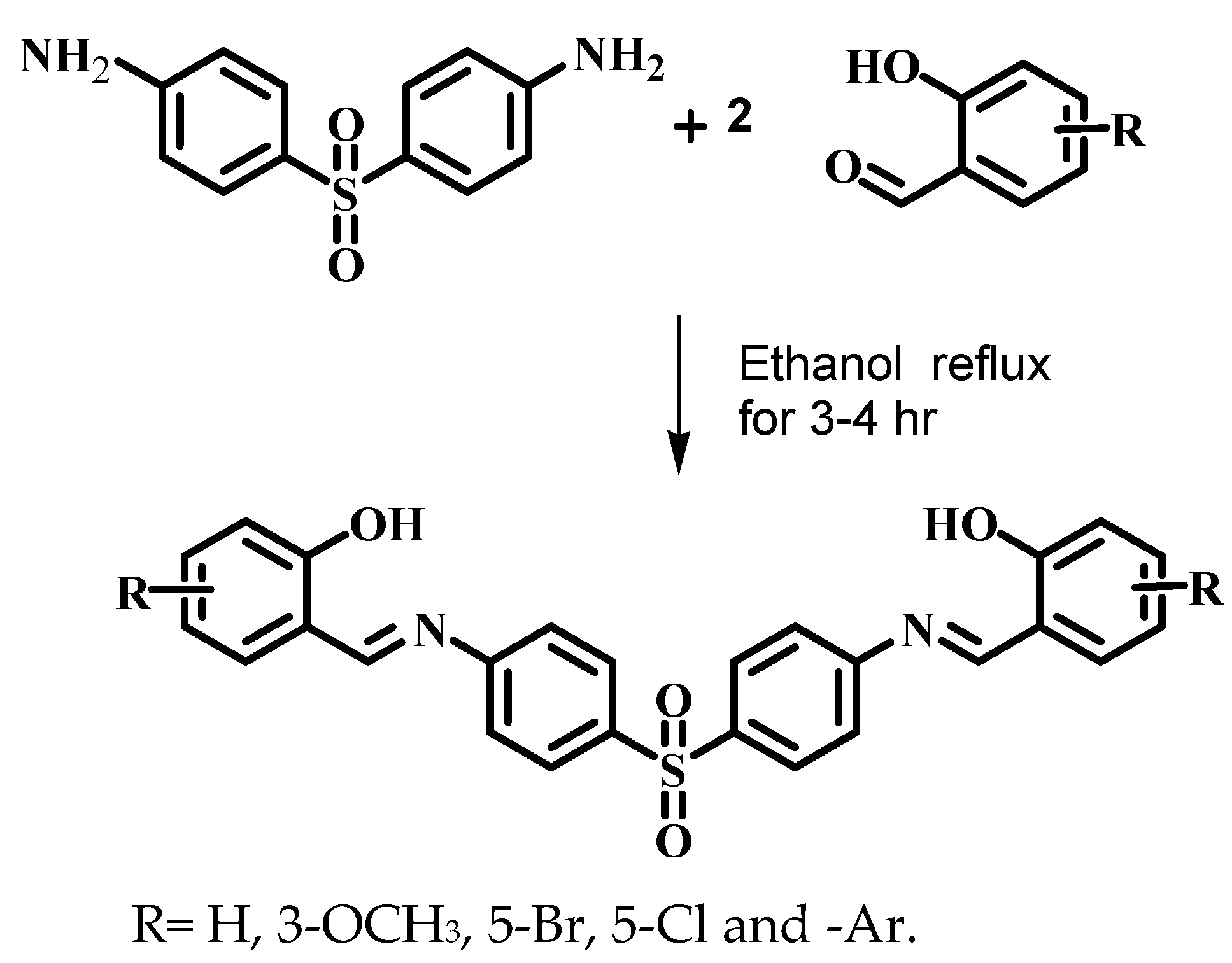
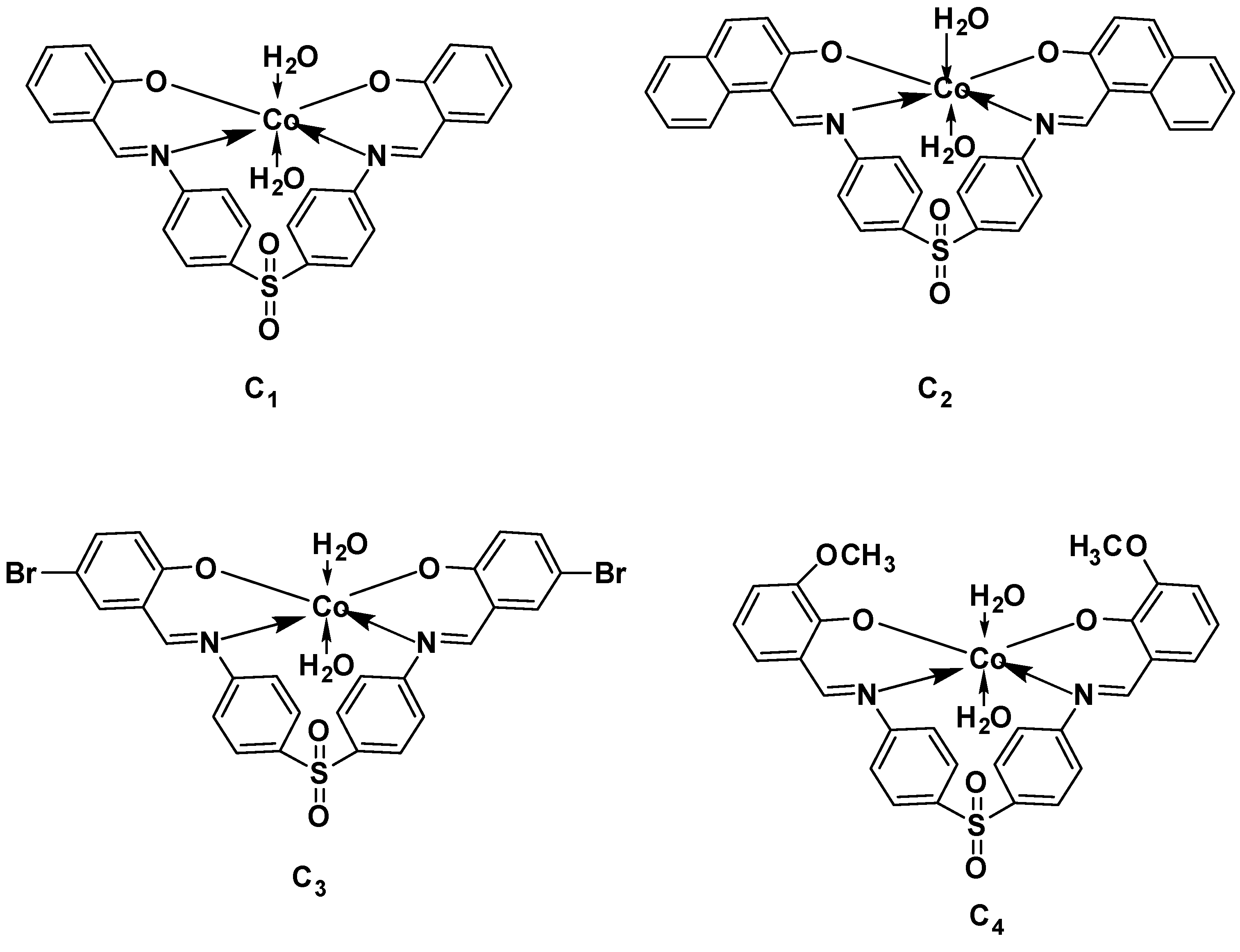
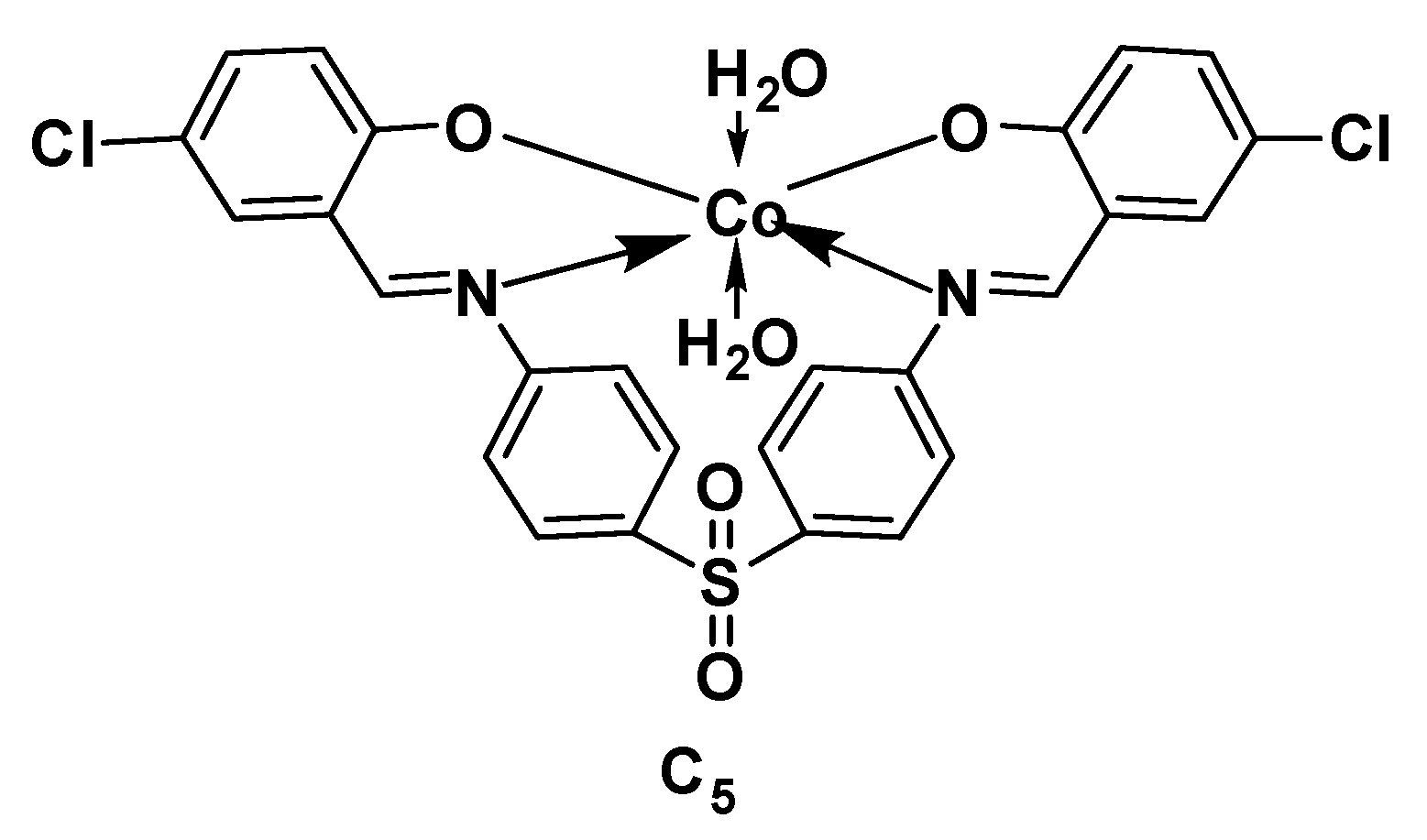
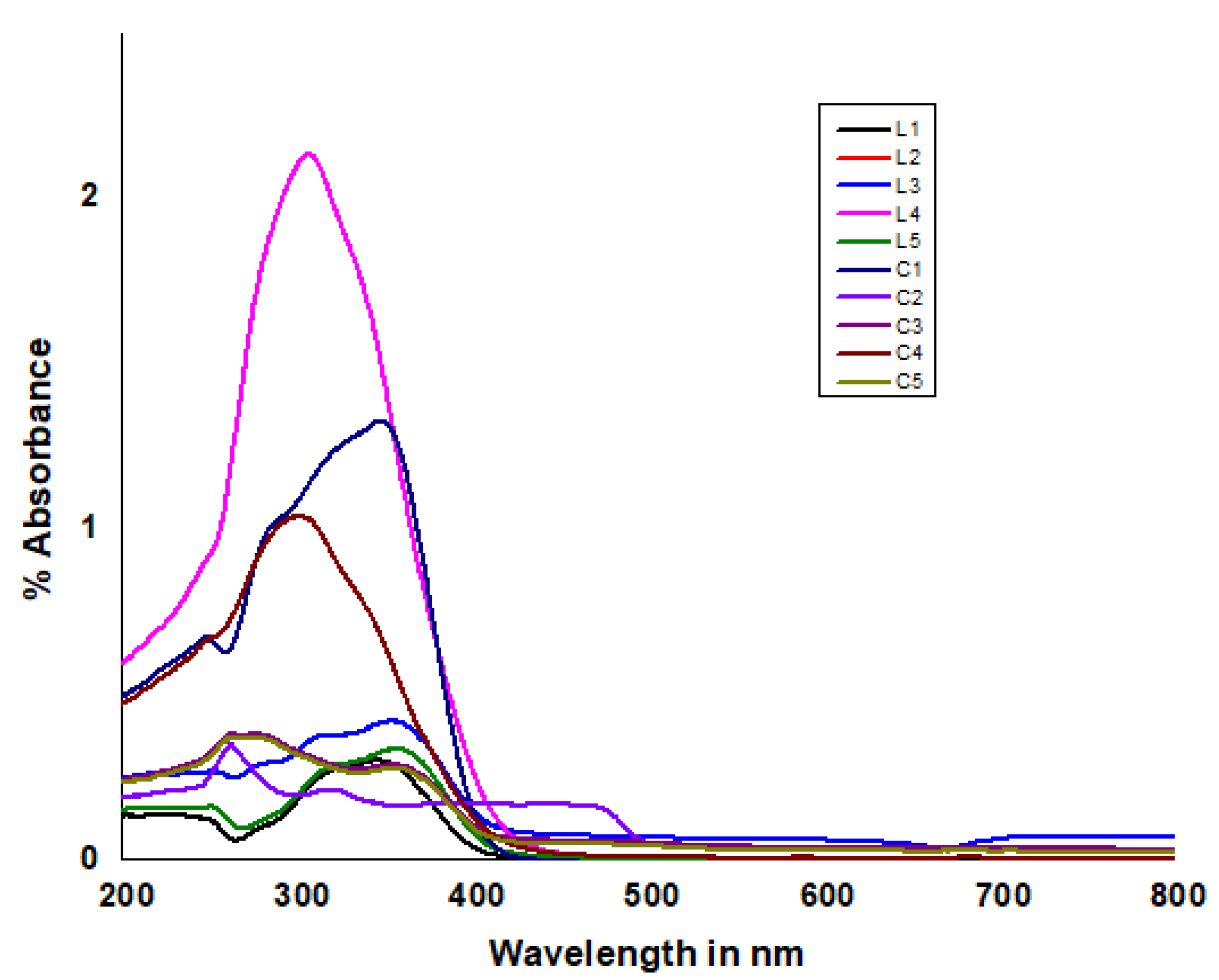
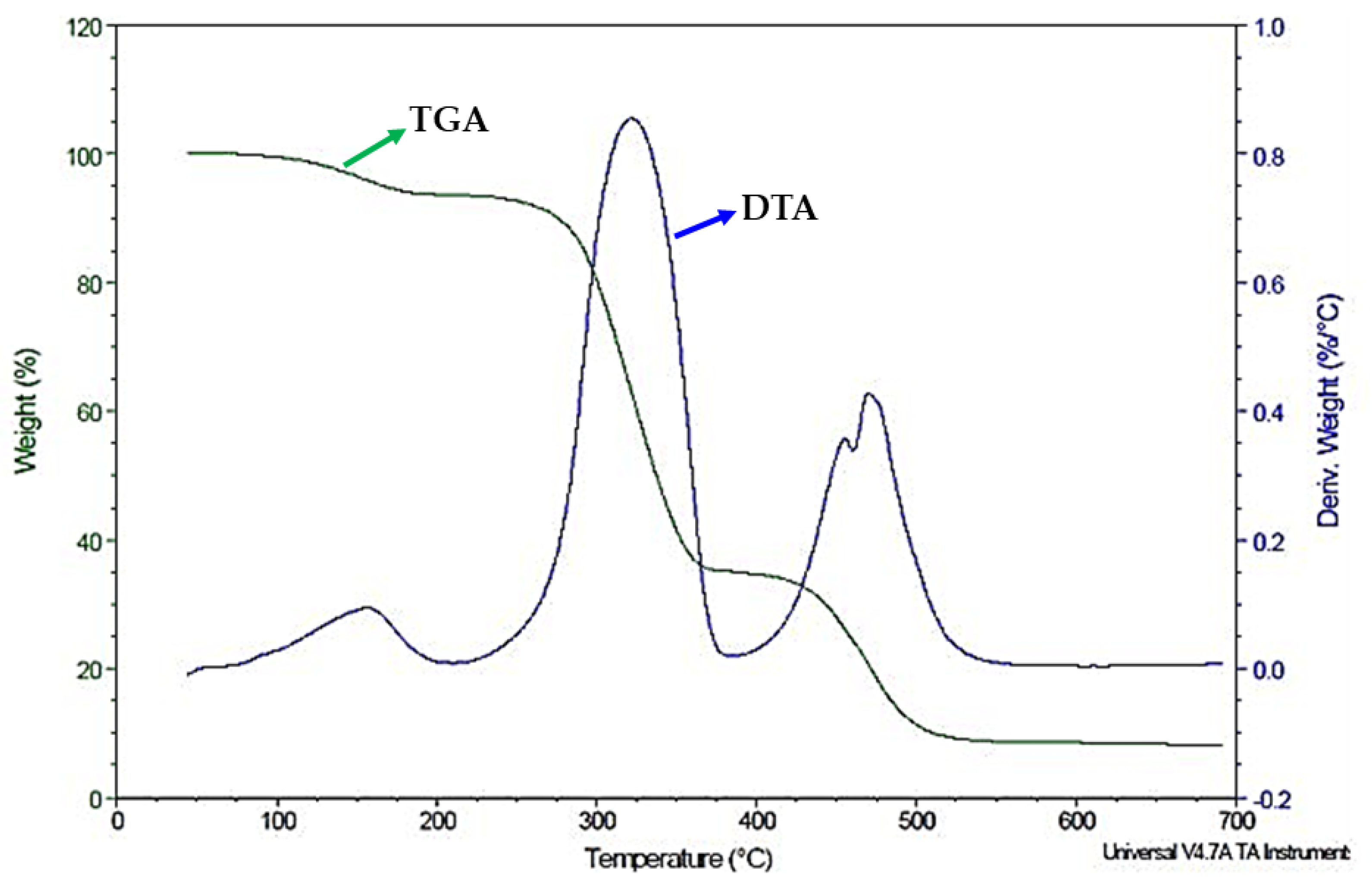
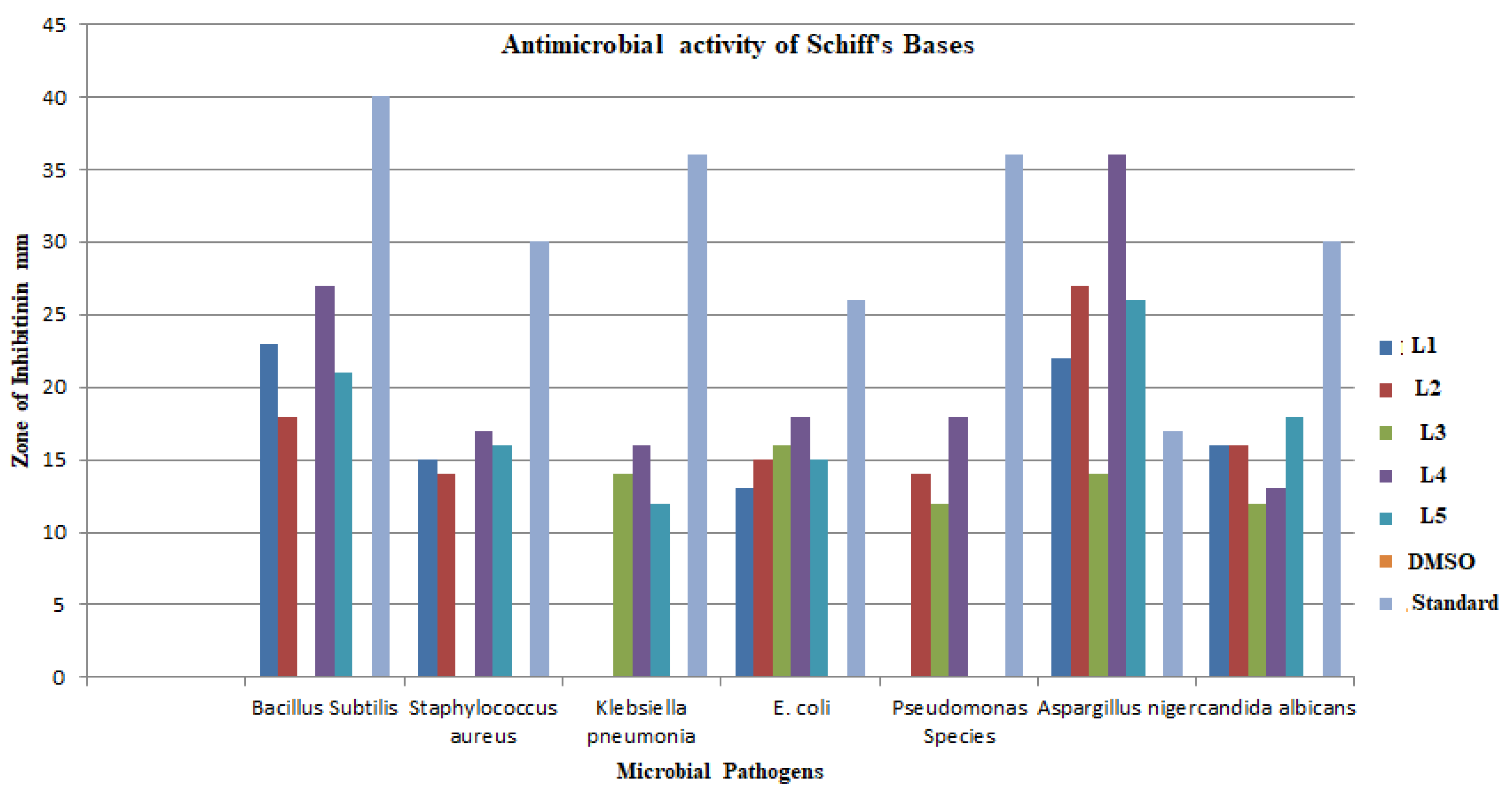


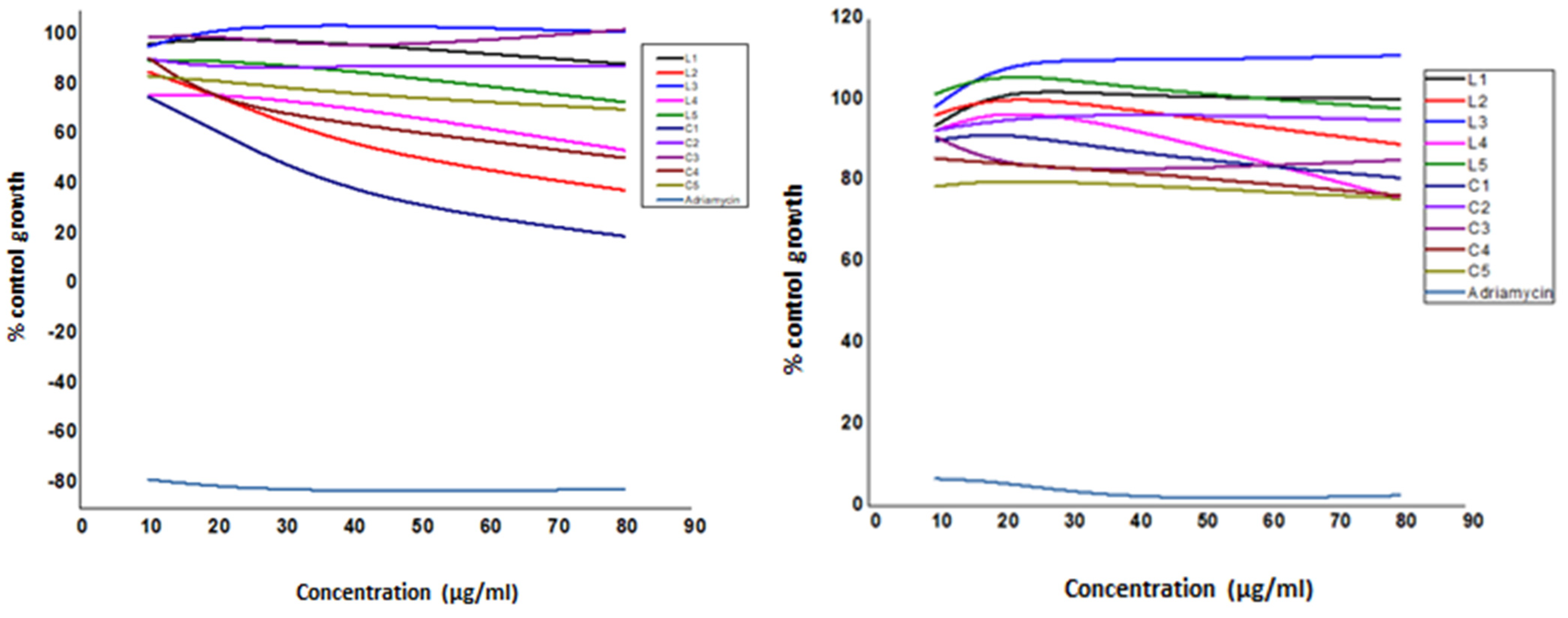
| Compound | Mol. Formula | Mol. Wt. | M.P. (°C) | Elemental Analysis | ||
|---|---|---|---|---|---|---|
| C% Found (calc.) | H% Found (calc.) | N% Found (calc.) | ||||
| L1 | C26H20N2O4S | 456 | 231 | 68.43(68.41) | 4.40 (4.39) | 6.21 (6.14) |
| L2 | C34H24N2O4S | 556 | 239 | 73.42 (73.26) | 4.65 (4.48) | 5.13(5.17) |
| L3 | C26H18Br2N2O4S | 614 | 233 | 50.18 (50.07) | 2.93 (2.86) | 4.56 (4.48) |
| L4 | C28H24N2O6S | 516 | 249 | 65.16(65.12) | 4.80 (4.74) | 5.53 (5.48) |
| L5 | C26H18Cl2N2O4S | 524 | 260 | 60.46 (60.33) | 3.48 (3.41) | 5.42 (5.35) |
| C1 | C26H22N2O6SCo | 549 | 347 | 57.19 (56.97) | 4.08 (4.00) | 5.37 (5.13) |
| C2 | C34H26N2O6SCo | 649 | 332 | 62.98 (62.89) | 4.09 (4.03) | 4.37 (4.31) |
| C3 | C26H20N2O6SBr2Co | 705 | 319 | 45.07 (44.56) | 2.93 (2.86) | 4.12 (3.99) |
| C4 | C28H26N2O8SCo | 609 | 352 | 56.23 (55.34) | 4.37 (4.30) | 4.77 (4.63) |
| C5 | C26H20N2O6SCl2Co | 617 | 324 | 51.76 (50.77) | 3.32 (3.25) | 4.66 (4.55) |
| Complex | λmax (nm) | Band Assignments | µeff. (BM) |
|---|---|---|---|
| 248 | π-π* | ||
| C1 | 289 | π-π* | 4.47 |
| 345 | n-π* | ||
| 250 | π-π* | ||
| C2 | 283 | π-π* | 4.37 |
| 399 | n-π* | ||
| 277 | π-π* | ||
| C3 | 290 | π-π* | 5.08 |
| 375 | n-π* | ||
| C4 | 255 310 | π-π* n-π* | 4.86 |
| 245 | π-π* | ||
| C5 | 342 | n-π* | 4.68 |
| Compound | υ (OH/H2O) | υ (C=N) | υ (M-N) | υ (M-O) |
|---|---|---|---|---|
| L1 | 3459 | 1615 | - | - |
| L2 | 3434 | 1619 | - | - |
| L3 | 3427 | 1621 | - | - |
| L4 | 3432 | 1614 | - | - |
| L5 | 3457 | 1627 | - | - |
| C1 | 3367 | 1614 | 544 | 514 |
| C2 | 3433 | 1620 | 552 | 511 |
| C3 | 3435 | 1610 | 562 | 510 |
| C4 | 3402 | 1596 | 547 | 505 |
| C5 | 3369 | 1601 | 552 | 517 |
| Compound | Thermogravimetry (TG) | Mass Loss (%) | Decomposition Product Loss | ||
|---|---|---|---|---|---|
| Stage | Temp (°C) | Found | Calculated | ||
| C1 | I | 120–250 | 7.05 | 6.55 | -2H2O |
| II | 250–440 | 80.74 | 82.91 | Organic moiety | |
| III | 440–1000 | 11.02 | 10.19 | -CoO | |
| C2 | I | 120–260 | 6.11 | 5.47 | -2H2O |
| II | 260–410 | 81.03 | 82.98 | Organic moiety | |
| III | 410–1000 | 10.91 | 11.55 | -CoO | |
| C3 | I | 120–320 | 6.14 | 5.11 | -2H2O |
| II | 320–425 | 83.69 | 84.26 | Organic moiety | |
| III | 425–1000 | 11.11 | 10.63 | -CoO | |
| C4 | I | 120–305 | 7.02 | 5.91 | -2H2O |
| II | 305–410 | 82.31 | 81.79 | Organic moiety | |
| III | 410–1000 | 10.96 | 12.30 | -CoO | |
| C5 | I | 120–250 | 4.96 | 5.83 | -2H2O |
| II | 250–450 | 83.03 | 82.03 | Organic moiety | |
| III | 450–1000 | 12.35 | 12.14 | -CoO | |
| Microorganisms. | L1 | L2 | L3 | L4 | L5 | DMSO | Standard a |
|---|---|---|---|---|---|---|---|
| Zone of growth inhibition in diameter (mm) | |||||||
| Gram Positive | |||||||
| Bacillus subtilis(ATCC 6633) | 23 | 18 | - | 27 | 21 | - | 40 |
| Staphylococcus aureus (ATCC 6538) | 15 | 14 | - | 17 | 16 | - | 30 |
| Gram negative | |||||||
| Klebsiella pneumonia (ATCC 13883) | - | - | 14 | 16 | 12 | - | 36 |
| Escherichia coli (ATCC 8739) | 13 | 15 | 16 | 18 | 15 | - | 26 |
| Pseudomonas aeruginosa (ATCC 9027) | - | 14 | 12 | 18 | - | - | 36 |
| Fungal pathogens | |||||||
| Aspergillus niger (ATCC 16404) | 22 | 27 | 14 | 36 | 26 | - | 17 |
| Candida albicans (ATCC 10231) | 16 | 16 | 12 | 13 | 18 | - | 30 |
| Microorganisms | C1 | C2 | C3 | C4 | C5 | DMSO | Standard a |
|---|---|---|---|---|---|---|---|
| Zone of growth inhibition in diameter (mm) | |||||||
| Gram Positive | |||||||
| Bacillus Subtilis(ATCC 6633) | - | - | - | - | - | - | 32 |
| Staphylococcus Aureus (ATCC 6538) | 16 | - | 16 | 27 | 20 | - | 30 |
| Gram Negative | |||||||
| Klebsiella pneumonia (ATCC 13883) | - | - | 08 | 16 | - | - | 28 |
| Escherichia coli (ATCC 8739) | - | 15 | - | 36 | 30 | - | 30 |
| Pseudomonas aeruginosa (ATCC 9027) | - | - | - | 16 | 12 | - | 28 |
| Fungal Pathogens | |||||||
| Aspergillus niger (ATCC 16404) | 18 | 16 | - | - | - | - | 28 |
| Candida albicans (ATCC 10231) | 15 | - | - | 13 | - | - | 29 |
| Compound | Lowest Binding Affinity (kcal/mol) | RMSD from Reference Structure (Å) | Hydrogen Bond Interaction | Hydrogen Bond Length in Å | Hydrophobic and Other Interactions |
|---|---|---|---|---|---|
| CDK7-L1 | −9.25 | 42.421 | PHE136 | 2.85 | LEU158, LEU134, ARG179, LEU183, ILE133, ARG136, LEU184, ASP218 |
| ARG188 | 2.81 2.84 | ||||
| TYR190 | 2.61 | ||||
| CDK7-L2 | −9.40 | 35.068 | ARG 188 | 2.59 2.73 3.08 3.13 | TYR190, LEU134, ARG136, ASP137, LEU 158, THR175, ARG176, ARG179, PHE162 |
| CDK7-L3 | −9.12 | 37.191 | ARG179 | 2.79 | LEU134, ARG136, LEU 183, LEU184, ASP218 |
| TYR190 | 3.02 | ||||
| CDK7-L4 | −7.11 | 43.983 | ARG136 | 2.89 2.95 3.27 | ARG179, PHE162, LEU158, ARG188, MET189, LEU134 |
| TYR190 | 3.27 2.6 | ||||
| CDK7-L5 | +285.63 | 35.985 | ARG179 | 2.64 | GLU99, LYS139, PRO140, TRP177, THER175, ARG176, ARG136, LEU183, LEU138, LEU158, GLY157, PHE162 |
| ASN141 | 3.05 |
| Compounds | Lowest Binding Affinity (kcal/mol) | RMSD from Reference Structure(Å) | Hydrogen Bond Interaction | Hydrogen Bond Length in Å | Hydrophobic and Other Interactions |
|---|---|---|---|---|---|
| CDK-7-C1 | −2.47 | 39.661 | GLN22 | 2.46 | ALA198, LEU183, ALA180, VAL194, TYR178, LYS139, THR175, ASP137, LEU138, LYS41, ASN142, PHE162 |
| PHE23 | 3.22 | ||||
| SER161 | 2.56 2.94 | ||||
| ARG136 | 2.36 | ||||
| ARG179 | 2.64 | ||||
| CDK-7-C2 | −8.09 | 42.083 | TYR190 | 2.80 | LEU134, PHE156, ILE133, GLU62, LEU158, ILE55 ARG136, ASP137, PHE162, ARG176, ARG179 |
| CDK-7-C3 | −4.18 | 43.033 | ARG188 | 3.00 2.53 | MET189, ILE55, PHE162, LEU134 |
| TYR190 | 3.25 | ||||
| CDK-7-C4 | −3.00 | 41.939 | ARG188 | 3.08 2.98 | MET189, PHE162, ILE55, GLY163, PRO165 |
| TYR190 | 2.79 2.81 | ||||
| CDK-7-C5 | −3.92 | 42.169 | ARG188 | 2.99 | MET189, LEU134, LEU158, PHE162, ILE55 |
| TYR190 | 2.90 2.56 |
| Concentration (μg/mL) | Average Values for % Control Growth | ||||||||||
|---|---|---|---|---|---|---|---|---|---|---|---|
| L1 | L2 | L3 | L4 | L5 | C1 | C2 | C3 | C4 | C5 | Adriamycin | |
| 10 | 96.3 | 85.0 | 95.2 | 75.7 | 89.7 | 74.9 | 90.3 | 99.1 | 90.6 | 83.2 | −78.5 |
| 20 | 98.9 | 75.7 | 103.1 | 76.3 | 89.9 | 61.4 | 86.4 | 99.9 | 72.5 | 81.7 | −81.6 |
| 40 | 96.5 | 53.3 | 104.2 | 71.0 | 85.6 | 33.7 | 87.4 | 93.5 | 63.8 | 75.8 | −83.6 |
| 80 | 88.2 | 37.5 | 101.0 | 53.6 | 73.0 | 19.1 | 87.6 | 102.0 | 50.5 | 70.0 | −82.5 |
| Concentration (μg/mL) | Average Values for % Control Growth | ||||||||||
|---|---|---|---|---|---|---|---|---|---|---|---|
| L1 | L2 | L3 | L4 | L5 | C1 | C2 | C3 | C4 | C5 | Adriamycin | |
| 10 | 93.6 | 96.2 | 98.3 | 92.3 | 101.4 | 89.9 | 92.4 | 90.8 | 85.5 | 78.6 | 6.6 |
| 20 | 103.4 | 101.5 | 110.1 | 98.2 | 107.3 | 92.4 | 95.3 | 83.2 | 84.2 | 80.3 | 5.9 |
| 40 | 100.5 | 97.3 | 109.6 | 93.1 | 102.5 | 86.5 | 96.8 | 82.4 | 82.1 | 79.0 | 1.1 |
| 80 | 100.2 | 89.0 | 110.8 | 75.7 | 97.8 | 80.7 | 94.9 | 85.1 | 76.4 | 75.6 | 2.5 |
Publisher’s Note: MDPI stays neutral with regard to jurisdictional claims in published maps and institutional affiliations. |
© 2022 by the authors. Licensee MDPI, Basel, Switzerland. This article is an open access article distributed under the terms and conditions of the Creative Commons Attribution (CC BY) license (https://creativecommons.org/licenses/by/4.0/).
Share and Cite
Gaikwad, K.D.; Ubale, P.; Khobragade, R.; Deodware, S.; Dhale, P.; Asabe, M.R.; Ovhal, R.M.; Singh, P.; Vishwanath, P.; Shivamallu, C.; et al. Preparation, Characterization and In Vitro Biological Activities of New Diphenylsulphone Derived Schiff Base Ligands and Their Co(II) Complexes. Molecules 2022, 27, 8576. https://doi.org/10.3390/molecules27238576
Gaikwad KD, Ubale P, Khobragade R, Deodware S, Dhale P, Asabe MR, Ovhal RM, Singh P, Vishwanath P, Shivamallu C, et al. Preparation, Characterization and In Vitro Biological Activities of New Diphenylsulphone Derived Schiff Base Ligands and Their Co(II) Complexes. Molecules. 2022; 27(23):8576. https://doi.org/10.3390/molecules27238576
Chicago/Turabian StyleGaikwad, Kundalkesha D., Panchsheela Ubale, Rahul Khobragade, Sachin Deodware, Pratibha Dhale, Mahadev R. Asabe, Rekha M. Ovhal, Pranav Singh, Prashant Vishwanath, Chandan Shivamallu, and et al. 2022. "Preparation, Characterization and In Vitro Biological Activities of New Diphenylsulphone Derived Schiff Base Ligands and Their Co(II) Complexes" Molecules 27, no. 23: 8576. https://doi.org/10.3390/molecules27238576
APA StyleGaikwad, K. D., Ubale, P., Khobragade, R., Deodware, S., Dhale, P., Asabe, M. R., Ovhal, R. M., Singh, P., Vishwanath, P., Shivamallu, C., Achar, R. R., Silina, E., Stupin, V., Manturova, N., Shati, A. A., Alfaifi, M. Y., Elbehairi, S. E. I., Gaikwad, S. H., & Kollur, S. P. (2022). Preparation, Characterization and In Vitro Biological Activities of New Diphenylsulphone Derived Schiff Base Ligands and Their Co(II) Complexes. Molecules, 27(23), 8576. https://doi.org/10.3390/molecules27238576








